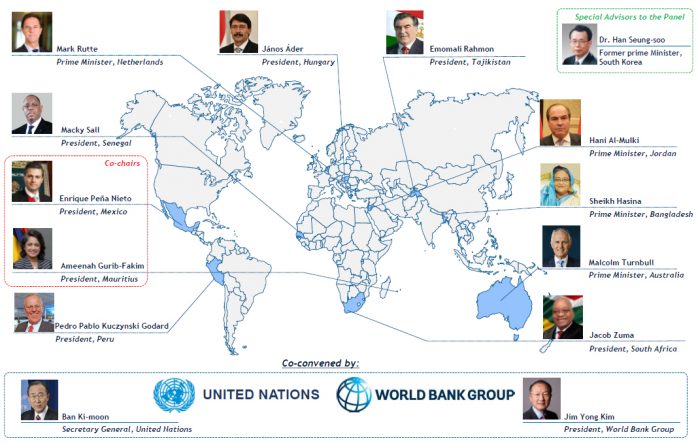Nick Michell spoke to leading water experts attending World Water Week in Stockholm, Sweden, about the future for the United Nations and World Bank Group High-Level Panel on Water
What one priority, exactly, should the High-Level Panel on Water do first, how should they do it, and why?
 John H. Matthews, Secretariat Coordinator, Alliance for Global Water Adaptation (AGWA)
John H. Matthews, Secretariat Coordinator, Alliance for Global Water Adaptation (AGWA)
“In terms of a recommendation for the High-Level Panel on Water, I’d say treating water not as a sector but as an enabler for development, integral for Sustainable Development Goals and other sectors. It is also important to ensure that they make good use of emerging sustainable water management knowledge and practice.”
 Barbara Frost, Chief Executive, WaterAid UK
Barbara Frost, Chief Executive, WaterAid UK
“We believe what is required is for those on the panel to galvanise the efforts of governments and their development partners to collaborate and focus on developing credible national plans that attract the right investment to deliver universal access to water and sanitation services (Goal 6), as without this the goal of eradicating extreme poverty by 2030 will not be reached. Accountability for this and “leaving no one behind” should be vested in the Sanitation and Water for All partnership.
Sustainable services that reach the poor will not be achieved by a single initiative. It requires governments having the right plans in place, taking accountability and enabling private sector investment through proper regulation that ensures affordable services reach even the most marginalised communities and that promotes effective consumer involvement.”
 Dheigen Naidoo, Chief Executive Officer, Water Research Commission
Dheigen Naidoo, Chief Executive Officer, Water Research Commission
“While the world’s water challenges are well described in UN reports, the Global Risk Registers, national statements and the general, very justified, outcry from civil society, we have seen no significant water behaviour changes outside drought conditions in any part of the world, developed or developing.
The key issue is a lack of Global Water Solidarity in action. There is a need for a deepening of the understanding, not only of the value of water, but also of the need for sustained collective action to work toward global water security, which in turn enables global food, health and energy security and ultimately global peace and stability. In order to catalyse a worldwide water solidarity in action, I would ask UN Secretary-General Ban Ki-moon’s High-Level Panel on Water to launch a Global Water Ubuntu campaign.”
 Anders Berntell, Executive Director, 2030 Water Resources Group/IFC
Anders Berntell, Executive Director, 2030 Water Resources Group/IFC
“I think we need to focus on, and this includes the High-Level Panel on Water, financing and investments in the water sector. I see the water sector as very broad, so it is not just the traditional aspects of water supply and sanitation that we need to invest in, but also areas such as agriculture, municipal and industrial wastewater, effluent water, reuse and recycling for various purposes and of course water storage.
The financial models that we have today are not working so we need to develop new, innovative ones. There is not one business case that fits all, so we need a multitude of new models, relating to the different kind of investments you are looking for. We can use some of the more traditional methods, whether it is public, private or PPPs, but we also need to look towards and develop avenues like social entrepreneurship and green bonds. But we have to go further and develop new financial solutions that we haven’t really thought of before.”
 Jaime Melo Baptista, Principal Researcher of the National Laboratory of Civil Engineering, Portugal, and Chairman of the Strategic Council of the Portuguese Water Partnership
Jaime Melo Baptista, Principal Researcher of the National Laboratory of Civil Engineering, Portugal, and Chairman of the Strategic Council of the Portuguese Water Partnership
“The priority must be to encourage the adoption of effective and sound public policies at country level, to accelerate availability and sustainable management of water supply and sanitation for all. The IWA Lisbon Charter for public policy and effective regulation recommends the methodology. A public policy needs an integrated approach and should include: adoption of strategic plans; definition of the legal and institutional framework; the governance of the services; the access targets and quality of service goals; the tariff policy; provision and management of the financial resources; construction of the infrastructure; improving the structural and operational efficiency; human resources capacity building; promotion of research; development of the economic activity; introduction of competition; protection and involvement of users; and provision of information.
Financial requirements to provide adequate water infrastructure across the globe until 2030 are probably US$12 trillion. Money exists, but how can we attract investment to the sector? This depends on gaining trust and confidence from financial organisations. To do this we need to implement sound and credible public policies.”
 Professor Joan Rose, Homer Nowlin Chair in Water research, Michigan State University, and 2016 Stockholm Water Prize Laureate
Professor Joan Rose, Homer Nowlin Chair in Water research, Michigan State University, and 2016 Stockholm Water Prize Laureate
“If one examines the SDG 6 sub-goals carefully it is the control of human pathogens associated with excreta and sewage that will ultimately improve health and economic well-being of communities. The first priority has to be wastewater treatment to promote water quality for all ecosystem services and promote better resource management. There is not a “one- size-fits-all” approach for building wastewater infrastructure that meets the needs of all that is efficient, easily cleaned and safe. Information is available on the adequacy of small and large systems (dry and wet systems) for excreta and wastewater treatment so that appropriate choices can be made.
There are three key recommendations which will move the SDG6 goal forward and will propel the world forward in meeting their water priorities in the next 15 years: bring Ministries of Finance, Environment/ Water and Health together to discuss the value of wastewater treatment and resource recovery and the impact on economic development; set up regional water quality diagnostic centres for verification and capacity building; and build innovative pilot and demonstration facilities.”
 Yasmin Siddiqi, Principal Water Resources Specialist, Asian Development Bank
Yasmin Siddiqi, Principal Water Resources Specialist, Asian Development Bank
“The first priority should be to drive equitable distribution of water services and infrastructure between urban rich and poor and urban and rural areas. There is a widening gap in this context as reported by the Asian Development Outlook 2016 with some countries like Afghanistan, Cambodia, and Timor-Leste showing an increased rural–urban gap in both improved and piped water supply. In rural areas, Mongolia has the largest gap between rich and poor and similar high disparities are seen in improved access to sanitation in urban areas in South Asia with gaps of up to 80 percentage points between rich and poor.
Policies and interventions need to improve the targeting of actions for inclusive development and to achieve Sustainable Development Goal 6. Solutions depend on a country’s stage of economic development and extent of rural–urban integration. Broad based options include capturing better (and disaggregated) water supply and sanitation data to identify inequalities and target interventions. Also increasing support for water supply and sanitation and integrating it into project design across all regions.”
 James Dalton, Coordinator Global Water Initiatives, IUCN Global Water Programme
James Dalton, Coordinator Global Water Initiatives, IUCN Global Water Programme
“The main focus must be on protecting and restoring our freshwater systems. Trying to squeeze more out of rivers, glaciers, and groundwater is no longer an option. The High-Level Panel should focus on improving water allocation through better governance mechanisms that allow for greater coordination and cooperation among diverse water actors and sectors. We must all deliver more equitable allocations of water resources, sharing of benefits among multiple competing needs and protection and restoration of freshwater ecosystems.
We also need to increase investment in ecosystems as natural water infrastructure based on verifiable returns for ecosystem health, livelihoods and social development and economic growth. It is important to re-frame integrated water resources management using the strengths of multiple sectors and actors at different scales–the current modus operandi is not structured adequately to deal with the trillion dollar problem we face.”
 Benedito Braga, President, World Water Council
Benedito Braga, President, World Water Council
“Financing, financing and financing; not necessarily in that order. Why is this important? Because we know the actions that have to be implemented to make the less fortunate societies resilient to climate change impacts. It is important to stress that by and large the impacts of climate change are manifested through, by and with water. Longer droughts and more intense floods are likely to be more frequent under future climate conditions. How can this be done? Basically we need to increase our water storage capacity. For example, Ethiopia and Australia face similar climatic conditions, but their water storage capacity are 45 m3/inhabitant-year and 5,000 m3/inhabitant-year, respectively.
At the same time we need to have the proper governance structure in place, that is laws, regulations and institutions to make sure the infrastructure is used in a sustainable framework. This infrastructure and governance can only be implemented if the proper financing mechanisms are in place. This includes the use of the traditional IFI (World Bank, regional multilateral banks) and more recently pension funds, sovereign wealth funds and the green fund under discussion in the UN Climate Conventions.”








